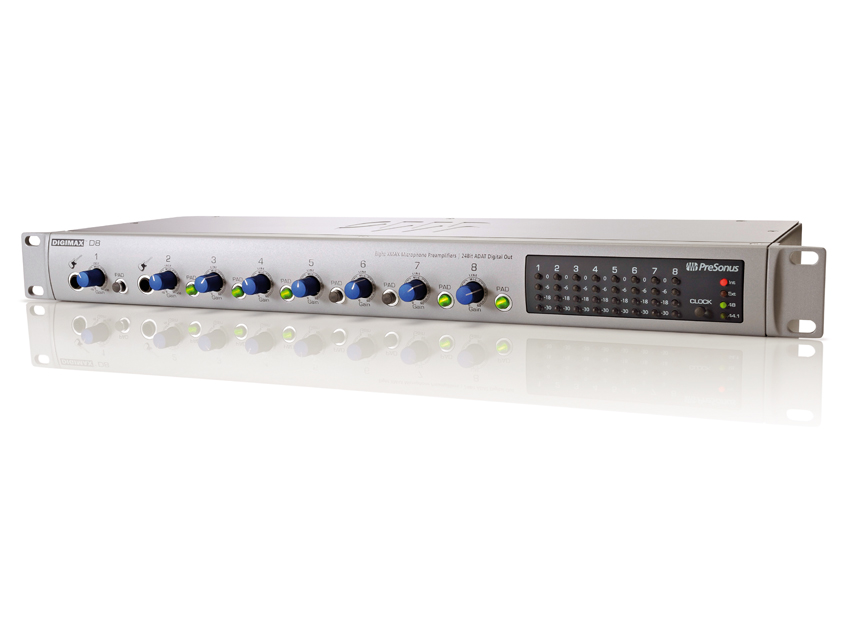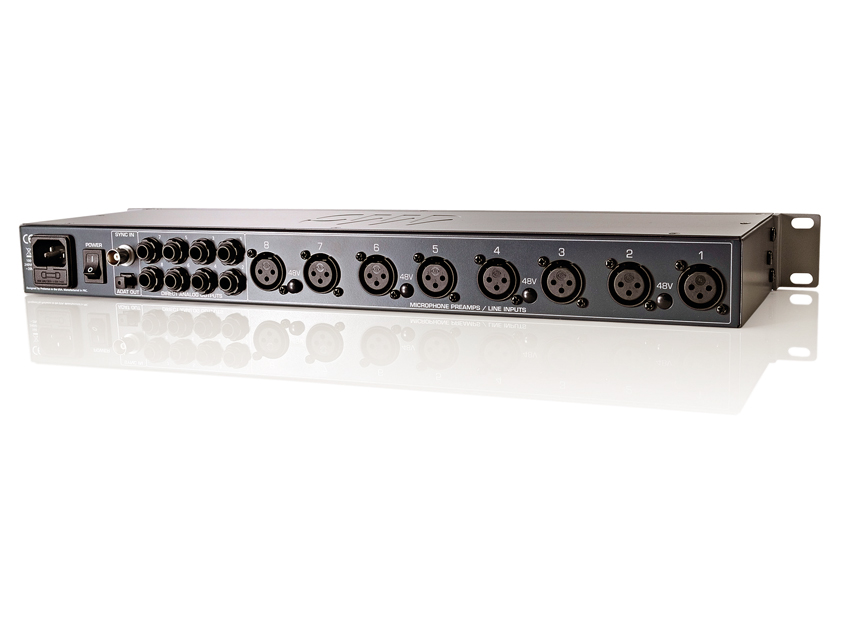MusicRadar Verdict
A simple set of preamps with a quality sound that's better than its price and feature set might suggest.
Pros
- +
Clean and full-sounding preamps. Quick and noiseless sample rate changes. Good quality A/D.
Cons
- -
LED metering not that informative. NO high-pass filters or phase flip options. No Combi jacks for inputs.
MusicRadar's got your back

PreSonus Digimax D8 Preamp

PreSonus Digimax D8 Preamp
PreSonus has now added a fourth eight-channel mic preamp to its Digimax range, and as with all the others, it's based around Class A dual servo preamp stages.
The D8 is the new budget version that forgoes the luxuries of 88.2/96kHz digital outputs and channel inserts, as found on the next model up, the Digimax FS. This stripped down approach brings the well-received XMAX mic preamp to a lower price.
Overview
On the front the D8 presents eight gain knobs with a backlit -20dB pad switch for each. The first two channels also feature a 1/4-inch TRS (used unbalanced as a TS) for Hi-Z instrument inputs. The metering section provides four LEDs per channel (-30dB, -18dB, -6dB and 0dB) and there is a four-LED sync clock display with a button to toggle between internal and external clock synchronisation and the two sample rates (44.1kHz and 48kHz).
At the rear, there are the eight XLR balanced mic/line inputs with +48v phantom power switches between each pair. Next in line are eight 1/4-inch TRS line outputs for analogue connection, while the digital output section features a single ADAT Toslink optical socket and a BNC word clock input.
Even though this is a budget conscious unit the power is still provided via an IEC socket and not a horrid external PSU.
What's missing?
Simplicity comes at some cost to flexibility as there are some features conspicuous by their absence. There are no high-pass filters or phase flip options, which in the former case means that unwanted low frequencies will eat up some of the precious amplifier headroom.
And though providing +48v per input pair instead of per channel is fine, locating the switches to the rear makes rack mounting problematic.
Instead of the ubiquitous XLR/TRS combo sockets the D8 only uses XLR for the inputs, which is fine for mics, but some users may have to get a TRS to XLR cable for line inputs.
Our only other gripe is that the only means for external digital syncing is via word clock. Though this is not a bad way to do it, many lower price interfaces have ADAT and S/PDIF outputs. The word clock input is also not self terminating like some designs so a 75 terminator may well be another expense, though we tried it without and found no evidence of clocking problems.
In use
There are a few operational observations to note. Firstly, we found the four-LED metering to be useable but not all that informative as regularly hitting the 0dB mark could be under or over by quite a margin.
Obviously, the dynamic character of the source has a large part to play in this matter; we found that short transients that crossed the 0dB line were not creating an audible distortion so we'd still prefer the four LEDs to not having them at all.
Despite our grumble about the lack of digital clocking sources we found the D8 very quick to change sample rate when clocked externally and it made no noise when doing so - other units are far less forgiving.
So, what does the XMAX preamp sound like? In a word - clean. In several words - clean, full and really rather pleasing. Across the frequency range, there are no over-hyped areas, no telltale roll offs at the extremities and a quick transient response that sorts the men from the boys when it comes to drum and percussion recordings.
We have an old classical guitar called 'the Dog' (as a dog chewed the headstock and it sounds really 'woofy') that we use to challenge preamps, EQs and microphones. If they don't make it sound worse then they don't have that muddy low-mid response that is the hallmark of poor audio circuitry.
The D8 passed the test with condensers, dynamic mics and ribbons on the Dog and many other sources (drums, guitar and bass amps and vocals). The 60dB of gain is easily enough, though it did run flat out with the ribbons on acoustic guitar which is pretty normal.
The noise floor is admirably low and is no more pronounced than much higher priced preamps that we compared it to.
The D8 is not a characterful preamp, nor should it be. The extreme high and low frequencies are well proportioned to the rest of the frequency range and overall tend towards a flat response.
The instrument input is similarly good quality, though there is a slight roll off at the low end compared to other more costly units. There is plenty of gain even for the most weedy of guitars and the noise floor is low. The A/D conversion via ADAT is more than adequate and doesn't seem to restrict the quality of the preamps.
Running tests at line level to compare the digital and analogue outputs, there was almost no obvious audible difference.
Summary
The Digimax D8 is aimed at a budget-minded marketplace and easily fits the bill. With regard to sound quality, we would happily recommend it for use in project studios and live rigs, and to anyone who needs some extra channels they can rely on without blowing £1,000 or more.
Our concerns about the +48v switches on the back panel, the lack of phase flip and high pass filters still stand, but they are outweighed by the audio quality available at this price.
If you want to work at higher sample rates then the Digimax FS would be a better bet, but do consider whether you are really going to benefit at an audible level - it's not that clear cut. The feature set of the other Digimax models may have been tempered to create a cheaper option, but it is nice to note that the sound has not been skimped on.
For the price, you'd be hard pushed to match this and would have to spend well over £1,000 to get an appreciable qualitative difference.
Future Music is the number one magazine for today's producers. Packed with technique and technology we'll help you make great new music. All-access artist interviews, in-depth gear reviews, essential production tutorials and much more. Every marvellous monthly edition features reliable reviews of the latest and greatest hardware and software technology and techniques, unparalleled advice, in-depth interviews, sensational free samples and so much more to improve the experience and outcome of your music-making.
“A synthesizer that is both easy to use and fun to play whilst maintaining a decent degree of programming depth and flexibility”: PWM Mantis review
“I feel like that song had everything we needed to come back with”: Bring Me The Horizon’s Lee Malia on Shadow Moses, its riff and the secrets behind its tone, and why it was the right anthem at the right time
“I said, ‘Are we sure we can write a song about death?’”: The story of Mike + The Mechanics' classic No.1 The Living Years










